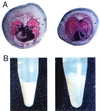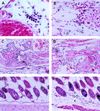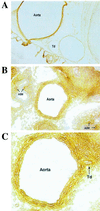Fatal bilateral chylothorax in mice lacking the integrin alpha9beta1
- PMID: 10866676
- PMCID: PMC85969
- DOI: 10.1128/MCB.20.14.5208-5215.2000
Fatal bilateral chylothorax in mice lacking the integrin alpha9beta1
Abstract
Members of the integrin family of adhesion receptors mediate both cell-cell and cell-matrix interactions and have been shown to play vital roles in embryonic development, wound healing, metastasis, and other biological processes. The integrin alpha9beta1 is a receptor for the extracellular matrix proteins osteopontin and tenacsin C and the cell surface immunoglobulin vascular cell adhesion molecule-1. This receptor is widely expressed in smooth muscle, hepatocytes, and some epithelia. To examine the in vivo function of alpha9beta1, we have generated mice lacking expression of the alpha9 subunit. Mice homozygous for a null mutation in the alpha9 subunit gene appear normal at birth but develop respiratory failure and die between 6 and 12 days of age. The respiratory failure is caused by an accumulation of large volumes of pleural fluid which is rich in triglyceride, cholesterol, and lymphocytes. alpha9(-/-) mice also develop edema and lymphocytic infiltration in the chest wall that appears to originate around lymphatics. alpha9 protein is transiently expressed in the developing thoracic duct at embryonic day 14, but expression is rapidly lost during later stages of development. Our results suggest that the alpha9 integrin is required for the normal development of the lymphatic system, including the thoracic duct, and that alpha9 deficiency could be one cause of congenital chylothorax.
Figures





References
-
- Bradley A. Teratocarcinomas and embryonic stem cells. In: Robertson E J, editor. Production and analysis of chimaeric mice. Oxford, United Kingdom: IRL Press; 1987. pp. 113–151.
-
- Erle D J, Sheppard D, Breuss J, Rüegg C, Pytela R. Novel integrin α and β subunit cDNAs identified using the polymerase chain reaction. Am J Respir Cell Mol Biol. 1991;5:170–177. - PubMed
-
- Fässler R, Meyer M. Consequences of lack of beta 1 integrin gene expression in mice. Genes Dev. 1995;9:1896–1908. - PubMed
-
- Fukamauchi F, Mataga N, Wang Y J, Sato S, Youshiki A, Kusakabe M. Abnormal behavior and neurotransmissions of tenascin gene knockout mouse. Biochem Biophys Res Commun. 1996;221:151–156. - PubMed
Publication types
MeSH terms
Substances
Grants and funding
LinkOut - more resources
Full Text Sources
Other Literature Sources
Molecular Biology Databases
Research Materials
